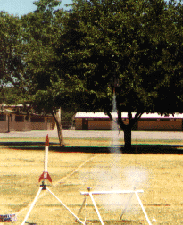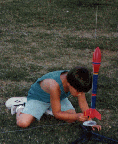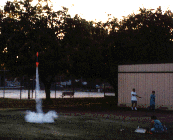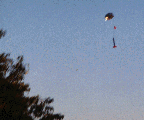

Here, Joe is carefully packing the egg in its protective sleeve, prior
to loading it into the payload bay. Estes sure makes it easy!

The egg is loaded, the recovery system (parachute) has been packed, and
the motor properly inserted with an ignitor installed. We always launch
and fly our rockets in accordance with the manufacturer's instructions,
National Association of Rocketry (NAR) guidelines, and local laws and ordinances.

5! 4! 3! 2! 1! Ignition! The Omloid with its special cargo is
on its way. The motors are always ignited electrically from a safe distance.
Joe is in the lower right-hand corner of the photo with the launch control
system.


The Omloid is now coasting towards apogee. (That's one of the cool things
about rocketry - you get to use cool words like "apogee"!) During
the un-powered coast phase, the motor emits a white "tracking"
smoke. Soon after the rocket reaches apogee (There's that cool word again!),
the motor's ejection charge ejects the recovery system, in this case an
18" mylar parachute.

Here, the Omloid is drifting slowly to earth. Sure hope that 'chute is
big enough to keep the egg safe! (It's not as close to those "rocket
eating trees" as it looks!)

This is always an exciting way to end a successful launch - catch it
before it touches the ground! (And there's never a shortage of willing volunteers!)

The egg is unbroken! We had sent a raw egg 300' into the atmosphere without
cracking it. We were very happy with the outcome. My wife asked me why we
were so excited about this... I couldn't answer her! I guess it was just
the challenge, and doing something unusual. How many people can say that
they've done this? In any case, we had a great time doing this project together,
and learned a new (Albeit worthless!) skill to boot!